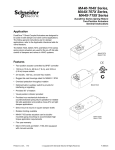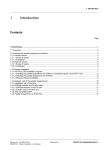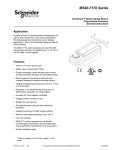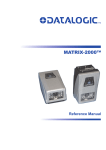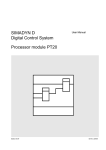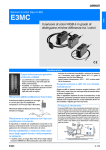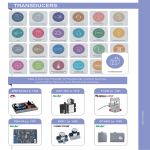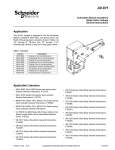Download Schneider Electric MA40-704X Series Specifications
Transcript
DS 3.325 05/02 MA40-704X-G0X MF40-7043-G0X MS40-7043-G0X TM 4Nm SPRING RETURN ROTARY ACTUATORS Invensys Spring Return Actuators have a rotary output for direct coupling to air dampers. Models are available for on/off operation from 230Vac or 24Vac power supplies and 24Vac Floating Point Control. There is also a 2-10Vdc input version that is fully modulating. A special feature of the design is that mounting brackets, universal joints and linking rods are not required for normal damper applications, thus reducing installation and commissioning time. FEATURES • Direct coupling to all normal dampers without mounting brackets or linkage kits - saves site time • Universal clamp provides direct mounting to damper shafts up to 15mm diameter or up to 13mm square (AM-710 accessory clamp required when mounting actuators to shafts up to 19mm diameter or 13mm square) • Case to IP 54 • Clockwise and Counterclockwise rotation available, determined by Left or Right Hand mounting • Spring tensions whilst the damper is being operated • Positive spring return operation, for example under power failure • Provides 95° of rotation; rotation limiting available • Visual position indicator • MX41-7043 Series actuators can be gang mounted to accommodate high torque requirements • Optional built-in auxiliary switches to provide for interfacing or switching • Cable Gland and Blanking plugs supplied fitted • MS4X-7XXX Series provided with Left/Right switch for selection of direct or reverse action control mode. Notes: Using Invensys damper actuators The actuators listed in this data sheet are intended for the operation of air dampers in HVAC systems. Torque requirements When calculating the torque required to operate dampers, it is essential to take into account all the data supplied by the damper manufacturer concerning cross sectional area, design, mounting and air flow conditions. Invensys is a trademark of Invensys plc and its subsidiaries and affiliates. Multi-Lingual Instructions MLI 3.325 - Installation Instructions DS 3.325 2-8 05/02 SPECIFICATIONS TYPE MA40-7041-G00 MA40-7041-G01 MA40-7043-G00 MA40-7043-G01 MF40-7043-G00 MF40-7043-G01 MS40-7043-G00 MS40-7043-G01 POWER SUPPLY - Voltage - VA (60Hz) - VA (50Hz) - Watts (Running) - Watts (Holding) 230Vac ±10% 6.0 8.3 5.4 2.6 24Vac ±20% 4.9 5.0 4.0 2.2 24Vac ±20% 8.1 8.7 4.0 2.2 ELECTRICAL CONNECTION 24Vac ±20% 7.8 8.1 3.5 1.5 0.9m cable. AUXILIARY SWITCH - INPUT CONTROL SIGNAL On-off, spring return. SPST control contacts or Triacs (500mA rated). 24Vac 2 to 10Vdc @ 80kΩ or 4 to 20mAdc @ 500Ω Open/Close with single pole contact control. Floating Point Control. Proportional Modulation Control. ACTION POSITION FEEDBACK One SPDT 6A (1.5A) @ 230Vac, UL listed, adjustable 0 to 95° (0 to 1 scale). - One SPDT 6A (1.5A) @ 24Vac, UL listed, adjustable 0 to 95° (0 to 1 scale). 95° ± 5° max. Adjustable (see end of stroke limits). END OF STROKE LIMITS Stroke limiting device. Stop block adjuster used to limit angle of rotation from 40° to 95°. DAMPER SHAFT CLAMP Universal mounting clamp used for shafts up to 15mm diameter, 13mm square. Up to 0.74m2 based on 0.042 Nm per m2 of damper area (but see damper manufacturer’s specifications) POSITION INDICATOR Visual Indicator 0 to 1 (0 is spring return position). <50s <26s <50s <26s AMBIENT TEMPERATURE LIMITS - Shipping & Storage - Operating <130s <25s -40 to 71°C -30 to 50°C HUMIDITY 15 to 95%rh non-condensing PROTECTION CLASS APPLICATION One SPDT 6A (1.5A) @ 24Vac, UL listed, adjustable 0 to 95° (0 to 1 scale). Clockwise or Counterclockwise rotation, determined by Left/Right Hand mounting. ANGULAR STROKE AGENCY LISTINGS - 4Nm (minimum) DIRECTION OF ROTATION RUNNING TIME (@ 21°C) - Motor Operation - Spring Return One SPDT 6A (1.5A) @ 24Vac, UL listed, adjustable 0 to 95° (0 to 1 scale). MS40-7043: 2 to 10Vdc (max. 0.7mA) output signal for position feedback or to operate slave actuators. OUTPUT TORQUE NOMINAL DAMPER AREA - IP 54 UL 873: Underwriters Laboratories (File # E9429 Category Temperature-Indicating and Regulating Equipment. CUL: UL Listed for use in Canada by Underwriters Laboratories. Canadian Standards C22.2 No. 24-93. European Community: EMC Directive (89/336/EEC). Low Voltage Directive (72/23/EEC). Two-position control from a thermostat, time switch or other switching device having a mains rated change-over contact. Two-position control from a thermostat, time switch or other switching device having a 24V rated change-over contact. Floating Point Control. Modulating control from any controller providing a 2-10Vdc positioning signal e.g. KMC, CZT, DRTE, MMC, BAS, IAC, MicroNet, Invensys Σ ACCESSORIES OPERATION AM-674 - Weather Shield AM-675 - Base Mounting Plate for AM-674 AM-676 - Universal Shaft Extension, to lengthen damper shaft by 229mm. Requires two AM-710 Universal Mounting Clamps. AM-703 - Input Rescaling Module, adjusts signals to 2-10Vdc, zero and span adjustment AM-704 - Interface, pulse width modulation AM-705 - Positioner AM-706 - Min and/or Manual Positioner for flush panel mount AM-707 - Digital Indication AM-708 - 500Ω resistor for 0 to 20mA control signal AM-709 - Damper Position Indicator AM-710 - Universal Clamp for up to 19mm diameter shafts AM-711 - Crank Arm for up to 13mm round shaft AM-712 - Crank Arm Adaptor Kit AM-713 - Mounting Bracket for Honeywell Mod IV, M6415 type actuators, and new installations AM-714 - Weather Shield (polycarbonate) AM-715 - Crank Arm Adaptor Kit for Honeywell Mod IV M6415 type actuators, and new installations AM-756 - Metric Conduit Adapter M20 x 1.5 to 1/2” NPT WARNING THESE ARE SPRING RETURN ACTUATORS. KEEP CLEAR OF ALL MOVING PARTS AT ALL TIMES. The direction of operation of the spring return function and motor operation of all models is determined by left hand or right hand mounting onto the damper. All actuators are directly mounted onto the damper shaft using a universal mounting clamp and provide true mechanical spring return operation for reliable, positive close-off on air tight dampers. When power is applied, the actuator moves to its powered position, at the same time tensing the spring return safety mechanism. When the power is removed, the spring returns the actuator to its normal position. The spring return system provides consistent torque to the damper with, and without, power applied to the actuator. All actuators provide 95° of rotation and are equipped with a graduated position indicator showing 0 to 1. Some models are provided with two built-in auxiliary switches. The SPDT switches are provided for interfacing or signalling, for example, fan start-up. The switching function is adjustable between 0° to 95° rotation (0 to 1 scale). 05/02 3-8 INSTALLATION The actuator is fitted directly to the damper and the clamp tightened securely to the damper shaft. A universal anti-rotation bar is supplied with each actuator and must be fitted to prevent rotation during operation. A stroke limiting device (stop block) is used to limit the stroke between 40 and 95°. Precautions (General) WARNINGS MA40-7041 SERIES ACTUATORS OPERATE AT MAINS VOLTAGE AND THEREFORE PRESENT A POSSIBLE ELECTRICAL SHOCK HAZARD. DISCONNECT THE POWER SUPPLY BEFORE AND DURING INSTALLATION TO PREVENT ELECTRIC SHOCK AND EQUIPMENT DAMAGE. OBSERVE LOCAL WIRING REGULATIONS AND EARTHING REQUIREMENTS. IF AUXILIARY SWITCHES ARE FITTED AND USED AT MAINS VOLTAGE, OBSERVE LOCAL WIRING REGULATIONS, EARTHING REQUIREMENTS AND ALL USUAL ELECTRIC SHOCK SAFETY PRECAUTIONS. Cautions Where screening is required, use either screened cable or MICC. Use an isolator with a minimum contact gap of 3mm (conforming to EN 60335-1) to isolate the MA40-7041 series actuators from the mains supply. MA41-7043, MF41-7043 and MS40-7043 Series actuators must be connected to 24Vac via a safety transformer conforming to EN 60742. MF40-704X and MS40-704X Series actuators contain a half-wave rectifier power supply. They must not be powered with transformers that are used to power other devices utilizing non-isolated full-wave rectifier power supplies. Refer to DS 10.250, Guidelines for Powering Multiple Devices from a Common Transformer, for detailed information. MA40-7043, MF40-7043 and MS40-7043 series actuators are not recommended for applications needing multiple actuators mounted on a common shaft. Avoid electrical noise interference. Do not install near large contactors, electrical machinery, or welding equipment. For applications requiring flexible metal conduit, use reduced (thin) wall types only. Do not exceed ratings of the device(s). Federal Communications Commission (FCC) Note: This equipment has been tested and found to comply with the limits for a Class B digital device, pursuant to Part 15 of the FCC Rules. These limits are designed to provide reasonable protection against harmful interference in residential installations. This equipment generates, uses, and can radiate radio frequency energy and may cause harmful interference if not installed and used in accordance with the instructions. Even when instructions are followed, there is no guarantee that interference will not occur in a particular situation—which can be determined by turning the equipment off and on—the user is encouraged to try to correct the interference by one or more of the following measures: • Reorient or relocate the receiving antenna. • Increase the separation between the equipment and receiver. • Connect the equipment to an outlet on a circuit different from that to which the receiver is connected. • Consult the dealer or an experienced radio/television technician for help. Canadian Department of Communications (DOC) Note: This Class B digital apparatus meets all requirements of the Canadian Interference-Causing Equipment Regulations. European Standard EN 55022 Caution This is a Class B digital (European Classification) product. Location Cautions Avoid locations where excessive moisture, corrosive fumes, vibration, or explosive vapours are present. The actuator should only be mounted directly on the damper shaft in locations that clear the maximum dimensions of the actuator case and allow the actuator to be mounted flush to the surface of the terminal box and perpendicular to the damper shaft. DS 3.325 Note: Some terminal boxes have sheet metal screw heads or other protrusions near the damper shaft. In these cases, a spacer or shim may be added under the anti-rotation bracket of the actuator to make the actuator perpendicular to the shaft. Before mounting the actuator, determine the direction of rotation and take into account the length of the damper shaft. These are covered in the following section. Mounting Note: The zero (0) position on the position indicator is the normal or spring return position. When the actuator is mounted with the 'R' side facing the installer and the control system initiates actuator movement (either by applying the appropriate voltage, increasing the control signal or by driving the actuator open, as appropriate), the actuator will rotate in the counterclockwise direction. Similarly, when the actuator is mounted with the 'L' side facing the installer and the control system calls for actuator movement, the actuator will rotate in the clockwise direction. 1. Move the damper to its normal position. Check that the controller action is set to match the damper application, as follows: a. For normally closed damper - when damper is closed, actuator position indicator should be approximately 0°. When damper is open, the actuator position indicator should be approximately 90°. b. For normally opened damper - when damper is open, actuator position indicator should be approximately 0°. When damper is closed, the actuator position indicator should be approximately 90°. Note: The actuator is usually shipped with the universal mounting clamp mounted to the 'L' side of the actuator. 2. Determine the direction of rotation required by the damper application and ensure that the clamp is on the correct side; if the clamp is not on the correct side, remount it as follows: a. Find the letters 'R' and 'L' on opposite tabs on the clamp. b. If mounting the actuator with the 'L' side out, position the clamp so that the pointer section of the tab with the 'L' is positioned at 0 and the spline pattern of the clamp mates with the spline of the actuator. Slip the clamp over the spline. c. If mounting the actuator with the 'R' side out, use the same procedure as for the 'L' side out, but use the 'R' tab instead of the 'L' tab. 3. Test for adequate shaft length by sliding the actuator over the shaft. The shaft should extend at least 3mm through the clamp. Long shafts should be at least 90mm, in which case the clamp should be fitted on the installer's side of the actuator, and short shafts should be at least 20mm, in which case the clamp should be fitted to the damper side of the actuator. Note: All actuators are shipped with a standard universal mounting clamp installed. For damper shafts larger than 16mm in diameter, the AM-710 universal mounting clamp is required (order separately). The AM-710 clamp accommodates round shaft sizes up to 19mm in diameter. 4. If mounting the actuator on a long damper shaft, continue as follows, otherwise follow the later procedure for mounting the actuator on a short damper shaft (Step 8.). Long Damper Shaft Mounting 10mm to 16mm square 10mm to 27mm diameter Min. 90mm Note: AM-710 required for shafts larger than 15mm diameter. 2 2 1 1 R L L R 'R' 'L' 1. Universal mounting clamp. 2. Retaining clip. Clockwise motor drive Counterclockwise motor drive Counterclockwise spring return Clockwise spring return DS 3.325 4-8 05/02 5. Secure the universal mounting clamp to the actuator using the retaining clip. 6. Position the damper at its normal (spring return) position and check that it is fully closed or completely open. 7. Continue from Step 12. (Position Indication and Pre-tensioning). Short Damper Shaft Mounting Universal Bracket 10mm to 13mm square 10mm to 19mm diameter Min. 20mm 90˚ Note: AM-710 required for shafts larger than 15mm. 2 L 2 3 3 R 15. Place a No.8 self-tapping screw in one side of the universal bracket and mount it the duct at the base of the actuator. Do not tighten the screw. 16. Pivot the universal bracket away from the actuator. Centre line L 1 1 2 R C L 2 'R' 'L' 1. Universal mounting clamp. 2. Retaining clip. 3. Damper position indicator Clockwise motor drive Counterclockwise motor drive Counterclockwise spring return Clockwise spring return 8. Determine the best orientation for the universal mounting clamp on the back of the actuator. The best orientation provides the easiest access to the two nuts on the V-clamp. 9. Engage the clamp to the actuator as close as possible to the determined orientation, then lock the clamp in place using the remaining retainer clip. 10. Place position indicator on the actuator and secure with the retainer clip. Ensure that the position indicator is at the before Pre-tensioning position (see following illustration). 11. Position the damper at its normal (spring return) position and check that it is fully closed or completely open. Position Indication and Pre-tensioning 0 1 .8 .6 .4 .2 With clamps loosened, rotate approx. 5° away from vertical, tighten clamps, then return to vertical 1.6 to 4.8mm 12. Slide the actuator over the shaft and verify that the position indication pointer on the universal mounting clamp is in the normal spring return position. .4 .2 0 L Correct universal clamp pointer mounting position if actuator is in normal spring return position (before Pre-tensioning) .4 .2 R Correct AM-709 pointer mounting position if actuator is in normal spring return position (before Pre-tensioning) .4 .2 0 L 0 .4 .2 0 R 13. Tighten the universal mounting clamp, finger tight only. 14. Align the universal bracket at the base of the actuator and drill mounting holes. Bend the bracket as needed to reach the duct. 17. Loosen the universal mounting clamp (making sure not to move the damper shaft) and rotate the actuator approximately 5° in the direction which would open the damper. 18. Tighten the universal mounting clamp to the shaft, ensuring that it is in the correct mounting position. 19. Manually rotate the actuator to align with universal bracket. 20. Pivot the universal bracket into place and secure both sides. 21. Tighten all fasteners. Tighten the two nuts on the clamp using a 7/16" spanner or socket and apply 8.2 to 10.8 Nm of torque. 22. Check that the universal clamp (or AM-709) pointer mounting position is at 5°. 23. Check that the universal mounting clamp (or AM-709) pointer mounting position is at 5° (see following illustration). .4 .4 Correct universal clamp pointer mounting position (after 5° Pre-tensioning) .2 0 .2 L .4 0 R .4 Correct AM-709 pointer mounting position (after 5° Pre-tensioning) .2 .2 0 0 L R 05/02 5-8 DS 3.325 . Installation of Universal Shaft Extension AM-676 Installation requires an AM-676 Universal Shaft Extension and two AM-710 Universal Mounting Clamps for 19mm shafts. These items must be ordered separately. 1 1 .8 .8 .6 .6 Actuator .4 AM-710 Universal Mounting Clamp assemblies Anti-rotation bracket (included with actuator) L .4 .2 .2 0 0 R 1 .8 .6 .4 .2 R 0 AM-676 Universal Shaft Extension Mounting surface V-clamp Duct Damper shaft AM-676 extends shaft approx. 229mm. 1. Loosen the V-clamp nuts on the AM-676 universal shaft extension. Fit the universal shaft extension fully onto the damper shaft and tighten the universal shaft extension V-clamp nuts with a 10mm open ended spanner. Apply 5.4 to 8.2 Nm of torque. 2. Position the damper at its normal (spring return) position. Verify that the damper is fully closed or completely open. 3. Remove the mounting clamps from the actuator and replace them with the AM-710 universal mounting clamps. Loosen the nuts on both of the AM-710 universal mounting clamps. 4. Assemble the actuator onto the universal shaft extension, following the same basic procedures as for 'Long Damper Shaft Mounting' and 'Position Indication and Pre-tensioning ', taking into account the direction of rotation required. Where 'universal mounting clamp' is mentioned, substitute 'AM-710 universal mounting clamps'. 5. Ensure that the AM-710 clamps are tightened to 8.2 to 10.8 Nm of torque. Note: If the universal shaft extension protrudes excessively above the actuator's top universal mounting clamp, remove the actuator from the universal shaft extension, remove the extension from the damper shaft and shorten the universal shaft extension by cutting it to the desired length. Jackshaft Installation (MA40-704X, MF40-7043, MS40-7043Series) The MA40-704X, MF40-7043 and MS40-7043 series actuators are designed for use with jackshafts up to 19mm in diameter. In most applications, the actuator may be mounted in the same manner as a standard damper shaft application. If the jackshaft diameter is larger than 16mm in diameter, the optional AM-710 universal clamp must be used. Adjusting an Auxiliary Switch (where fitted) The MA40-704X-G01, MF40-7043-G01 and MS40-7043-G01 actuators include one built-in SPDT auxiliary switch which can be used for interfacing or signalling (e.g., for fan start-up). The switch is adjustable between 0° and 95° of rotation (0 to 1 scale). To make an adjustment: 1. The actuator must be in its normal (spring return) position. 2. Use a flat screw driver to rotate the switch pointer until it is at the desired switch position on the 0 to 1 scale. Rotation Limitation The Stop Block is used in conjunction with the tab on the universal clamp or the AM 709 position indicator. In order to function properly, the clamp or indicator must be mounted correctly. The Stop Block is used in applications where a damper has a designed rotation that is less than 90°, for example with a 45° or 60° rotating damper. 1. Determine the amount of damper rotation required. The actuator stop block provides limited rotation from 40° to 95°. 2. Loosen the screw securing the stop block to the actuator. Note: The actuator is shipped with the Stop Block mounted to the 'L' side. If the damper application requires the 'R' side face the installer, simply remove the Stop Block and screw and move it to the new location. Adjusting Stop Block for Limited Rotation 3. Slide the stop block into position, so that its edge lines up with the degree graduation on the actuator face which corresponds with the required rotation. 4. Secure the stop block in place. 5. Test the damper rotation by applying power. Re-adjust if necessary. WIRING Precautions Class 2 control and power lead wiring must be routed separately from line voltage wiring and any other non-class 2 circuits. Line voltage, auxiliary switch and auxiliary switch leads must be connected to a Class 1 circuit. Actuator Type 24Vac 24Vac 24Vac 230Vac Spec Number MA40-7043-G00 MA40-7043-G01 MF40-7043-G00 MF40-7043-G01 MS40-7043-G00 MS40-7043-G01 MA40-7041-G00 MA40-7041-G01 Maximum Wires Run (metres) (5% Voltage Drop) 14 AWG 16 AWG 18 AWG 335 213 134 183 122 76 213 131 82 11,278 7,163 4,511 MAINTENANCE A periodic check of the control system is recommended. The spring power failure operations must be regularly checked by a competent person and can normally be carried out as part of the regular maintenance schedule. The spring checks are detailed below. Depending on site operation, this check should be carried out at least once every 6 months. If the checks are every 6 months then one of them should be carried out at the start of the heating season. Checking Power Failure Operation WARNING HANDS SHOULD BE KEPT AWAY FROM THE ACTUATOR DURING THIS OPERATION. Remove all power from the actuator and check for correct spring operation. DS 3.325 6-8 05/02 CONNECTION DIAGRAMS WARNING THESE ARE SPRING RETURN ACTUATORS. KEEP CLEAR OF ALL MOVING PARTS WHEN POWER IS REMOVED. ONLY SWITCH OFF POWER IF SPRING RETURN IS REQUIRED. TWO POSITION CONTROL - 230V TWO POSITION CONTROL - 24V MA40-7041-G00 MA40-7041-G01 Contact Closed: Actuator turns against spring return 230Vac MA40-7043-G00 MA40-7043-G01 Contact Closed: Actuator turns against spring return Brown 230Vac Red 24Vac (+) 0V (-) Light Blue Black Green/Yellow Green/Yellow Earth Use an isolator with a minimum contact gap of 3mm (conforming to EN 60335-1) to isolate the Provide overload protection MA40-7041 series from the mains supply. and disconnect as required. Provide overload protection and disconnect as required. Connect via a 24Vac safety transformer - see DS 25.001. Parallel connection of several actuators is possible. Observe power consumption. FLOATING POINT CONTROL - 24V MF40-7043-G00 MF40-7043-G01 Low/High Limit Thermostat Red 24Vac (+) Connect via a 24V safety transformer - see DS 25.001. Black 0V (-) Provide overload protection and disconnect as required. Blue Typical Floating Controller Yellow/Black Drive Open Drive Closed Green/Yellow Earth MODULATING CONTROL (2-10Vdc/4 to 20mAdc) Connect via a 24V safety transformer - see DS 25.001. Provide overload protection and disconnect as required. MS40-7043-G00 MS40-7043-G01 Low/High Limit Thermostat Red 24Vac (+) Grey (Note 3) Control Signal 2 to 10Vdc Notes: 1. Up to 4 actuators (mounted on separate shafts) may be connected in parallel. With four actuators mounted to one 500Ω resistor, a 2% shift of the control signal may be required. Power consumption must be observed. 2. A 500Ω resistor converts the 2-10V signal to 4 to 20mAdc. 3. Only connect the common (grey) to the negative leg of the control circuit. 4. To reverse actuator rotation, use the reversing switch (MS40-7XXX). Black 0V (-) (Note 2) Yellow/Black Blue 4 to 20mAdc to other actuators Earth Feedback Signal 2 to 10Vdc (Note 1) L R Green/Yellow AUXILIARY SWITCHES (IF FITTED) 230Vac Actuator types: MA40-7041-G01, MA40-7043-G01, MF40-7043-G01 and MS40-7043-G01 have one SPDT Aux Switch 1 6A (1.5A) 230V auxiliary switch built-in for end position indication or system interlock functions. Use an isolator with a minimum contact gap of 3mm (conforming to EN 60335-1) to isolate the MA40-7041 series from the mains supply. Yellow Wire No. NO Violet Orange Motor terminals: see appropriate wiring diagram above. Switch operating position NC COM 0 to 1 scale, adjustable WARNING AUXILIARY SWITCH MAY BE AT MAINS POTENTIAL. 230Vac 05/02 7-8 DS 3.325 DS 3.325 8-8 05/02 DIMENSION DRAWING 202 172 149 120 6 25 80 100 50 93 19 125 19.5 87 61.5 6 Dimensions in mm TM Building Systems - UK Invensys Energy Solutions Farnham Road Slough Berkshire SL1 4UH United Kingdom Telephone +44 (0)1753 611000 Facsimile +44 (0)1753 611001 Web site www.ies.invensys.com WARNINGS THESE ARE SPRING RETURN ACTUATORS. KEEP CLEAR OF ALL MOVING PARTS AT ALL TIMES. CERTAIN MODELS (AND AUXILIARY SWITCHES WHERE FITTED) OPERATE AT MAINS VOLTAGE AND THEREFORE PRESENT A POSSIBLE ELECTRICAL SHOCK HAZARD. DISCONNECT THE POWER SUPPLY BEFORE AND DURING INSTALLATION TO PREVENT ELECTRIC SHOCK AND EQUIPMENT DAMAGE. OBSERVE LOCAL WIRING REGULATIONS AND EARTHING REQUIREMENTS. THESE ACTUATORS ARE NOT SAFETY DEVICES AND SHOULD NOT BE USED ON FIRE DAMPERS. Cautions • Do not apply any voltages until a qualified technician has checked the system and the commissioning procedures have been completed. • If any equipment covers have to be removed during the installation of this equipment, ensure that they are refitted after installation to comply with UL and CE safety requirements. • MF40-704X and MS40-704X Series actuators contain a half-wave rectifier power supply. They must not be powered with transformers that are used to power other devices utilizing non-isolated full-wave rectifier power supplies. Refer to DS 10.250, Guidelines for Powering Multiple Devices from a Common Transformer, for detailed information. • MF40-7043 series, MA40-7043 series and MS40-7043 series must be connected to 24Vac via a safety transformer conforming to EN 60742. • Use an isolator with a minimum contact gap of 3mm (conforming to EN 60335-1) to isolate the MA40-7041 series from the mains supply. • Ensure wires are not inadvertently crossed over. • Carry out regular checks on the spring power failure operation as detailed on Page 5 under Maintenance. • Check torque requirements of damper (or other device) to be driven. Do not exceed rated output torque. • Interference with those parts under sealed covers renders the guarantee void. • The design and performance of Invensys equipment is subject to improvement and therefore liable to alteration without notice. • Information is given for guidance only and Invensys does not accept responsibility for the selection or installation of its products unless information has been given by the Company in writing relating to a specific applications. • A periodic system check of the control system is recommended. Please contact your local Invensys service office for details. © 2002 Invensys plc. All Rights Reserved.








